
|
| ©Temporary Temples |

|
| ©Lucy Pringle |
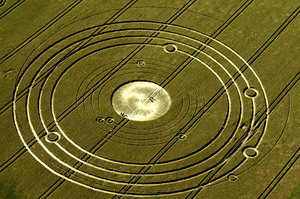
|
| ©Nick Nicholson |
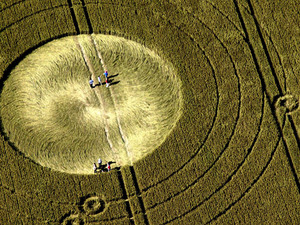
|
| ©Nick Nicholson |
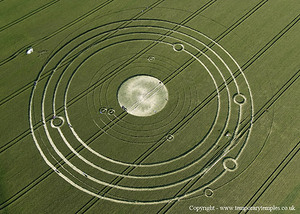
|
| ©Temporary Temples |
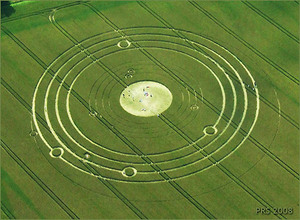
|
| ©Peter Sorensen |
This morning my friend Dr. Simeon Hein called to tell me that he had taken Ron Russell's tour to Avebury in the morning, and discovered a new crop formation adjacent to the North-West quadrant of the henge. Normally I would have immediately gone to have a look, as Avebury is close by, but I was tired from a late night, and just stayed in bed working on Email.
But then around noon my pilot, Dai Dobbs, wrote to say that he had bought a new 3-axis micro-light aircraft, and would I like to go for a cruse -- oh, boy, WOULD I?!
So soon we were headed for the new circle, and got good shots.
The new formation is obviously a diagrammatic representation of the Sun and planets (with no care for proper astronomical proportions). But the smaller inner ones (Mercury, Venus, Earth and Mars) are clearly delineated from the giant outer ones (Jupiter, Saturn Uranus and Neptune).
And there is a huge Sun with an unusual reversing swirl lay.
As for Pluto, is it another small planet and displayed the same as the little inner ones, with a small size and thin orbital line. I also know enough to recognize that it's orbit is symbolically correct in that it goes well outside of Neptune's path for most of the way, but for a while it is within the Sea God's orbit (note the upper left hand part).
I have an astronomer friend who I asked to check the planetary positions, but he said they do not match the present time.
Peter Sorensen
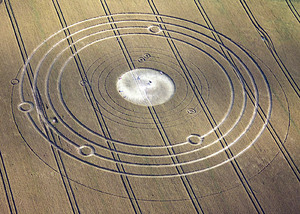
|
| ©Gary King - WCCSG |
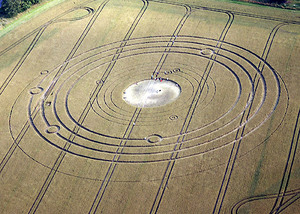
|
| ©Gary King - WCCSG |
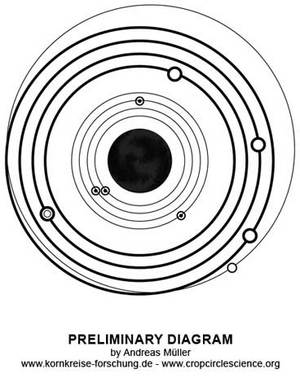
|
| ©Andreas Müller |
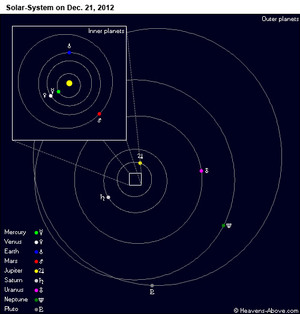
|
| ©Heavens Above |
The crop circle formation at Avebury Manor seems to depict our solar-system (not in proportional scale) on December 21, (+/-) 2012 - the highly debated end of the Mayan calendar (or at least one of the most prominent interpretations of that date). Whatever this means and who-or-whatever created this crop circle, I do not know - but the basic message of it is quite clear.
Andreas Müller
Kornkreise Forschung
Crop Circle Science
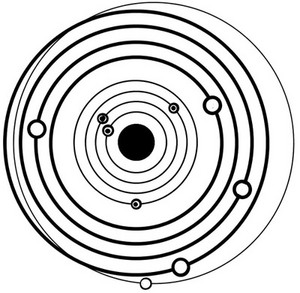
|
| ©Tommy Borms |
Avebury Manor of July 15, 2008 reminds us that the Mayan Long Count calendar will end on December 23, 2012: by showing precise orbital locations for all nine planets of our solar system on that date, plus an accurate elliptical orbit for Pluto
The 5125-year Mayan Long count calendar will end on December 22-23, 2012. Given the long period of time which it represents, all nine planets of our solar system need to be shown in order to mark its end uniquely. Such a clever astronomical diagram was shown at Avebury Manor on July 15, 2008. All nine planets appear there precisely as they will be located in space four and one-half years from now on December 23, 2012, with one exception.
Thus, the outermost planet Pluto has been drawn in this new crop picture somewhat further to the right (or closer to Neptune) than should be the case. Yet Pluto still seems to be located correctly relative to the crossover of its highly elliptical orbit with the orbit of Neptune. Three weeks ago at Secklendorf in Germany, two different dates from the year 2012 were indicated astronomically in a crop picture, one of which (December 21, 2012) was essentially the same as that shown here (see HERE).
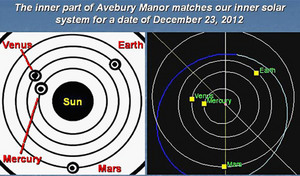
|
| ©Unknown |
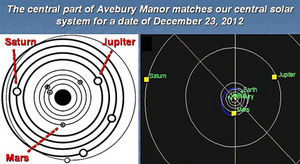
|
| ©Unknown |
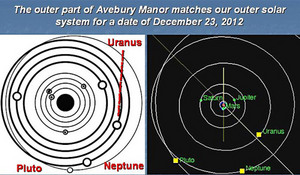
|
| ©Unknown |
December 21 or 23, 2012?
Many people believe that the Mayan Long Count calendar will end precisely on December 21, 2012. Yet a new crop picture from Avebury Manor shows planetary positions that match more closely December 23-24 than December 21. To be specific, Venus and Mercury will lie almost directly in line with the Sun on December 21, whereas on December 23-24, Mercury will lie a little ahead of Venus as shown (see HERE).
Since we are obtaining such new information directly "from the horse's mouth", I thought it more advisable to report the astronomical date they are actually showing us, rather than any preconceived date of our own. For example, modern scholars remain uncertain by two full days, whether the Long Count calendar began on August 11,12 or 13, 3114 BC (see HERE or HERE).
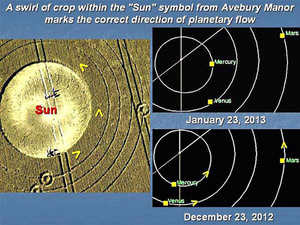
|
| ©Unknown |
| Crop swirls within its central "Sun" tell us which way the planets are moving! |
Red Collie
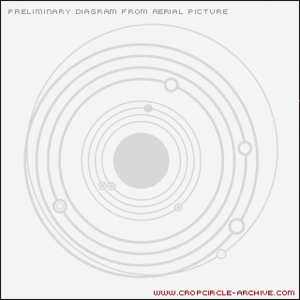
|
| ©Bertold Zugelder |



Reader Comments
to our Newsletter